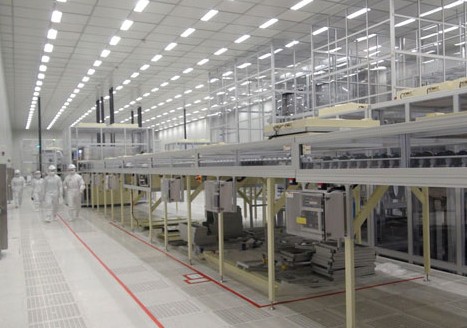

An assembly line of the 8.5 generation TFT-LCD products of BOE Technology Group Co in the Cloud Valley in southeastern Beijing. Provided to China Daily
"Once the assembly line starts operation, it's like turning on a bank note printing machine."
That was how the vice-president of Beijing-based BOE Technology Group Co, Zhang Yu, described the optimistic outlook of his company. And he has a reason for saying so.
China's largest flat panel manufacturer, BOE is expected to make profits of 2 billion yuan ($328.4 million) this year, a huge jump from last year's 258 million yuan, after it recovered from a decade long recession that killed off or damaged other companies in the panel industry.
To maintain the momentum, Zhang said the company is planning to roll out its most advanced assembly line producing organic light-emitting diodes (OLED) in Ordos, in the Inner Mongolia autonomous region.
"With this OLED assembly line, we would be able to top other companies in terms of technology in the industry in China," Zhang said. "And if everything goes well, we will be among the world's top three display giants by 2015."
Previously, South Korea's LG Display announced it had become the world's first display manufacturer to begin mass production of OLED panels.
Ordos' assembly line will become China's first plant and the world's second to deliver mass production of flexible OLED products for smartphones.
Zhang explained the new technology puts the OLED panels on plastic substratas, instead of glass ones, which gives them flexibility and makes the displays more durable under impact than traditional glass screens.
In addition, its cost of raw materials is 70 percent lower than the traditional thin film transistor-liquid crystal displays.
"The market for OLED is expected to grow very quickly because it will fulfill the requirements of automotive displays, tablets and wearable devices."
In addition to the upcoming plant in Ordos, BOE also boasts another seven production lines of TFT-LCD products, ranging from generation 4.5 to generation 8.5.
Higher generation of assembly lines is expected to produce larger panels and generate more profits.
"The panel industry is an industry for the wealthy," said Zhang, looking back to the past when the company was enduring a recession in recent years.
BOE only started to make a profit in 2011, when other companies making panel displays were also suffering from the global economic downturn.
"Sometimes you survived only because you kept at it. In terms of panel manufacturing, you can only live best when you live the longest," Zhang said.
A latest line of generation 8.5 in Beijing has cost the company 28 billion yuan. BOE's total investment will cost a further 100 billion yuan, if the assembly line at Ordos and another in Beijing are completed.
It is no wonder why BOE purchased shares in the Bank of Chongqing in late October, worth nearly $20 million. It was a bid to strengthen cooperation with Chongqing's government and local financial institutions.
To cement its supply of advanced display production equipment and to cut costs, BOE also teamed up with California-based Applied Materials Inc, a leading semiconductor equipment manufacturer, in August.
"The industry will continue to expand until 2017 at least, when it will see a balance in supply and demand," Zhang predicted.
Li Yaqin, head of research at Sigmaintell Consulting Co, a company providing panel industry consultancy, agreed that the panel production industry is facing a golden opportunity at the moment.
"Tablets measuring 5 inches (12 centimeters) are replacing tablets of 3 inches, which used to be standard for smartphones. In addition, it will take time to turn any investment into profits," she said.
Dong Yikai, a researcher at the National Engineering Laboratory of TFT-LCD Materials and Technologies, said the recovery of the whole industry may still face uncertainty because it is heavily affected by an increase in import tariffs.
China raised the import tariff on LCD panels to 5 percent starting in April 2012, at a time when several domestic LCD production lines had gone into operation, changing the market's dynamics.
Previously, China placed a 3 percent tax on imported LCD panels of 32 inches or bigger (excluding backlit modules) in size, in order to spur development of the country's booming television manufacturing sector, which is heavily reliant on LCD panel imports.
Dong said the tariff will have a positive effect on Chinese LCD panel and television manufacturers, because it will increase their competitive edge.
Copyright ©1999-2018
Chinanews.com. All rights reserved.
Reproduction in whole or in part without permission is prohibited.